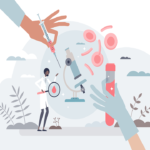What Is Pelvic Inflammatory Disease (PID)?

Allo Health is dedicated to personalized well-being, offering support and trusted information tailored to individual health goals. The platform emphasizes human-generated content, led by a distinguished medical team of experts, including physicians and sexual health specialists. Their commitment to credibility involves rigorous fact-checking, authoritative research, and continuous updates to ensure accurate, up-to-date information. Allo Health's unique approach goes beyond conventional platforms, providing expert-led insights and a continuous commitment to excellence, with user feedback playing a crucial role in shaping the platform's authoritative voice.

Dr Sanina Mansoor holds MBBS degree from Yenepoya university,Mangalore.She has 8 years of experience working as a medical officer at various health centres and medical colleges.
Why This Was Upated?
Our experts continually monitor the health and wellness space, and we update our articles when new information became available.
Updated on 20 June, 2025
- Article was updated as part of our commitment to diversity, equity, and inclusion.

Pelvic Inflammatory Disease (PID) is a serious infection of the female reproductive organs, including the uterus, fallopian tubes, ovaries, and surrounding tissues. It is a common and significant health concern among women of reproductive age and can lead to severe complications if left untreated. Let’s delve into the details of PID, including its causes, symptoms, diagnosis, treatment, prevention, and potential complications.
Causes of PID

PID is primarily caused by bacterial infections, most commonly sexually transmitted infections (STIs) such as Chlamydia trachomatis and Neisseria gonorrhoeae. These bacteria enter the female reproductive tract through the cervix and can spread upwards, infecting the uterus, Fallopian tubes, and ovaries. In some cases, non-sexually transmitted organisms like bacteria normally found in the vagina can also cause PID.
Risk Factors
Several factors increase the risk of developing PID:
- Multiple sexual partners or a new sexual partner
- History of STIs, particularly Chlamydia or gonorrhoea
- Previous episodes of PID
- Insertion of intrauterine devices (IUDs) for contraception
- Young age (adolescents and young adults)
- Engaging in sexual activity at an early age
- Having unprotected sex
Symptoms of PID
PID can present with a range of symptoms, which may vary in severity:
-
- Lower abdominal or pelvic pain
- Abnormal vaginal discharge, which may be yellow or green and have an unusual odour
- Painful urination (dysuria)

- Painful intercourse (dyspareunia)
- Irregular menstrual bleeding
- Fever and chills
- Nausea and vomiting
- Fatigue and general malaise
Diagnosis of PID
Diagnosis of PID involves a combination of medical history assessment, pelvic examination, and diagnostic tests:
- Medical history: The healthcare provider will inquire about symptoms, sexual history, contraceptive methods, and previous infections.
- Pelvic examination: This involves inspecting the external genitalia, vagina, cervix, uterus, and ovaries for signs of inflammation or infection.
- Laboratory tests: Tests such as vaginal swabs, cervical cultures, urine tests, and blood tests may be conducted to identify the causative bacteria and assess inflammatory markers.
- Imaging studies: In some cases, ultrasound or other imaging studies may be used to visualize the pelvic organs and detect abnormalities.
Treatment of PID
- Prompt treatment of PID is crucial to prevent complications and long-term consequences. Treatment typically involves a combination of antibiotics to target the underlying bacterial infection:
- Broad-spectrum antibiotics: These are prescribed to cover a range of potential bacterial pathogens causing PID. Commonly used antibiotics include doxycycline, azithromycin, ceftriaxone, and metronidazole.
- Partner treatment: Sexual partners of individuals diagnosed with PID should also receive treatment to prevent reinfection and transmission of STIs.
- Follow-up care: Follow-up appointments are essential to monitor treatment response, assess for complications, and ensure complete resolution of the infection.
Prevention of PID
- Preventive measures can significantly reduce the risk of developing PID:
- Safe sex practices: Using condoms consistently and correctly during sexual activity can prevent the transmission of STIs, reducing the risk of PID.
- Regular STI screening: Routine screening for STIs, especially Chlamydia and gonorrhea, can detect infections early and facilitate prompt treatment.
- Limiting sexual partners: Having fewer sexual partners and maintaining monogamous relationships can lower the risk of exposure to STIs.
- Avoiding douching: Douching disrupts the natural balance of vaginal flora and can increase susceptibility to infections, including PID.
- Proper hygiene: Maintaining good genital hygiene and seeking timely medical care for symptoms suggestive of infection can help prevent PID.
Complications of PID
- Untreated or inadequately treated PID can lead to severe complications and long-term health consequences:
- Infertility: PID can cause scarring and damage to the fallopian tubes, leading to infertility or ectopic pregnancy.
- Chronic pelvic pain: Persistent inflammation and scarring in the pelvic organs can result in chronic pelvic pain and discomfort.
- Tubo-ovarian abscess: Severe cases of PID may lead to the formation of abscesses (pus-filled pockets) in the fallopian tubes or ovaries, requiring surgical intervention.
- Increased risk of ectopic pregnancy: Scarring and damage to the fallopian tubes increase the risk of ectopic pregnancy, a life-threatening condition where the fertilized egg implants outside the uterus.
In summary, Pelvic Inflammatory Disease (PID) is a significant infection of the female reproductive organs, primarily caused by bacterial infections, especially sexually transmitted infections (STIs). Prompt diagnosis, appropriate treatment with antibiotics, preventive measures, and regular medical care are essential in managing PID, preventing complications, and preserving reproductive health.
The following blog article provides general information and insights on various topics. However, it is important to note that the information presented is not intended as professional advice in any specific field or area. The content of this blog is for general educational and informational purposes only.
Book consultation
The content should not be interpreted as endorsement, recommendation, or guarantee of any product, service, or information mentioned. Readers are solely responsible for the decisions and actions they take based on the information provided in this blog. It is essential to exercise individual judgment, critical thinking, and personal responsibility when applying or implementing any information or suggestions discussed in the blog.






